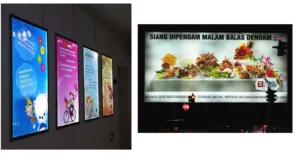In the 21st century, the word “DISPLAY” automatically equates to some kind of digital display. It could be a computer monitor, an LCD television, an LED video display, etc. Not too may years ago, it could have been a matrix display, a 16-segment alphanumeric display, etc. Very few people would think of a display as billboards in the freeways, posters at the store windows, and signs at the front of the stores.

I believe that analogue displays are still the majority of the displays today. With the advancement of digital displays, most people are getting used to video displays that can display moving images or a sequence of static images or a combination of both multiplexed either temporally or spatially. With the increasing speed of the Internet, most of these digital displays can be controlled remotely with information to be displayed and the sequence of the display images and video downloaded from a central location.
On the other hand, the non-digital displays have to have the images painted at the locations or created remotely and transported to the location and mounted. Let’s call these non-digital displays. In the old days, for larger billboards, such images were normally painted by technicians at the location by climbing up to the billboards with buckets of color paints. When the images needed to be changed, the old images would be removed and new images would be painted. Later on, the images were painted on canvas, vinyl, or other suitable materials, transported to locations, and mounted on the billboards.
As computer technologies advances, the painting process has become digital and such processes are still being practiced extensively today. The images are painted (actually considered as printed) by digital printers from a digital file onto appropriate materials (let’s call them canvases) suitable for the various environments. These printers are actually scaled-up versions of desktop ink jet printers. The ink cartridges are actually large buckets of paint and the inkjets are actually nozzles used for shooting various colored inks onto the canvas. Of course, the paint buckets and the nozzles are all computer controlled with the correct color and amount deposited on the appropriate location of the canvas forming the desired images.
The canvas is then transported (most likely shipped by FedEx) to the location and installed by a local crew onto the billboard. Beside some smaller non-digital displays which are mounted on top of light boxes for back lighting, most of the larger non-digital displays are illuminated from the front. The usual problem is that the illuminations are not bright enough and are not uniform. Most of them are still the old style front-lit type of display where several high power metal-halide or LED lamps are used for illumination. The better-designed ones are usually located in high traffic areas and the lower traffic area billboards are often neglected and have sub-standard viewing qualities.
Small back-lit posters (left) and front lit posters (right)
Recently, many of the high traffic area billboards that have a high cost per impression have been replaced by LED digital billboards, in locations such as Time Square, the Las Vegas Strip, Sunset Blvd., etc, but not in low traffic or low cost per impression locations. The reason is very simple. The revenue from the advertisers has to cover the cost and maintenance of the installation. For a standard size billboard, 48 feet by 12 feet (14m x 3.5m) , the costs run from about $200,000 to $500,000 per installation with the higher cost ones having high quality images. All of these LED digital billboards are used to display moving images or quasi-moving images (sequential static images) mainly limited by the local ordinances. As a result, the general public is spoiled by a high quality, bright display, putting standard non-digital displays not acceptable. This created the rebirth of light boxes for backlight non-digital displays. These light boxes are mostly; if not all are illuminated by power efficient LEDs.
In smaller backlit non-digital displays, most light boxes use the same backlight technologies as LCD displays so that thin profiles can be achieved. On the other hand, the display size is limited to the LCD display sizes with the upper limit of about 100 inches if cost is to be kept into a reasonable range.
Larger non-digital displays require larger light boxes which are actually constructed as a box with thickness ranges from 2” to 3” (5cm to 7.5cm) all the way to over 10” (25cm). Such light boxes are heavy and bulky and have to be installed in fixed locations near the ground. Recently, many of such light boxes are being installed in stores and shopping malls with display sizes that are over 10 feet (3m). It would be cumbersome to have such light boxes expanded to support standard 48′ by 12′ (14m x 3.5m) billboard sizes. On the other hand, it would be desirable to convert these front light billboards into back light billboards such that the quality can be comparable to the digital billboards.
Let’s look at the market size of such backlight billboard if the cost per installation is low enough for penetrations into lower traffic areas.
In the US alone, there are over 120,000 billboards located at various high and low traffic areas. Only a small portion of such billboard, about 10%, have been converted to LED digital billboards over the last 10 years, and these are all located in high traffic areas. Assuming the average cost of such systems is $400,000 per installation, the total market is about $48 billion. The assembly technology has been quite mature and the cost is not expected to be reduced substantially in the coming years. The rest of the locations simply do not have the traffic to support the cost of installation.
They are locations where a back-lit system would be perfect as the cost of installation would be much lower and the logistics for changing from front-lit to back-lit is minimal as the contents can be changed periodically as before. To avoid having a bulky and heavy light box, the thickness of the light box has to be small and, preferably, flexible for ease of transportation to the locations. It would also ease installation onto existing billboards without demolition of the existing structure and the cost of constructing a new structure.
ith an expected cost of such installation in the range of $60,000 per location compared to $400,000 for LED digital displays, the market penetration is expected to be very high. Assuming an 80% market penetration over the next 10 years, the total market for full-size billboards would be about $57 billion, which is similar to the digital billboard market size over the last 10 years.
The total installed base of smaller-size billboard is about 400,000 locations with the average size being half of the full size billboards. Again, assuming 80% market penetration, the total market for small-size billboard would be about $96 billion. The total US market would then be about $150 Billion. The worldwide, non-US market for such billboards is about three times the US market, so totalling about $450 billion. Summing the two give a total world market of $600 Billion. This is definitely not a small market to be ignored. It is expected that with properly designed back-lit systems at low cost, I would expect that the whole world will be full of non-digital, back-lit displays of all sizes in various locations.
Of course, the development depends on the development of low cost efficient backlight systems, a topic I have studied. Ken Li
You can contact Ken at [email protected].


